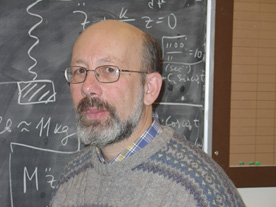Alexander Shnirelman has mathematics in his bones

Alexander Shnirelman
Photo by Alan Wong
When mathematician Alexander Shnirelman arrived here last fall from Russia via Israel and England, he brought with him years of experience, not only in academia, but also in industry.
Professor Shnirelman now holds the Canada Research Chair in Applied Mathematics, in Concordia’s Department of Mathematics and Statistics. His main area of interest is the turbulent flow of fluids, a field that includes some of the last major unsolved problems in physics and mathematics.
Shnirelman grew up in Moscow in the 1950s, where his mother taught mathematics at a military school and his father was an astronomer.
“It was a time when there were new discoveries in science every month,” he recalls, and he attended a school where students studied advanced mathematics. He also took part in mathematics competitions, and admits, “once I got a first, but I usually came in second or third.” He then did his undergraduate and graduate degrees in math at Moscow State University, and completed his PhD in 1972.
“There was no academic work available, mainly because of anti-Semitism, and it was difficult to leave the Soviet Union at that time, so I found work in industry, at the Oil and Gas Institute, and worked there for many years.”
In 1991, he finally left Russia when Tel-Aviv University invited him to teach there. He also spent two years at the University of Hull, in the United Kingdom, before coming to Montreal in the fall of 2004.
As a Tier 1 research chair, he will concentrate on research, but is also teaching some courses. He says he enjoys the diversity of students at Concordia, but commented that the way mathematics is taught today, it does not become “part of a student’s bones” as it did when he was a student in the Soviet Union.
Shnirelman developed an interest in fluid mechanics, trying to find mathematical ways to describe the behavier of fluids. “In the oil industry, everything is flowing.” Oil encounters resistance as it flows through miles of pipes. Engineers try to solve such problems in practical ways, but as a mathematician, he wants to understand what goes on at a deeper level.
Shnirelman said most problems in mathematics originate in applied problems. “Today, most of the more accessible problems are more or less solved, so now it is the toughest problems that are left.”
That is certainly true for the field that is his main interest: turbulence. Examples of turbulent fluids include water in oceans and rivers, blood pumping through the circulatory system, and molten iron at the core of the Earth.
Flow and the motion of viscous fluids are described by some differential equations, but they describe smooth, simple motion; none comes close to describing turbulent motion. “These may be the most difficult equations to solve in all of mathematics.”
Another subject that interests him applies to the medical field, and has to do with understanding what happens to cartilage — the plastic-like material that gives the human nose its shape, for example — when it is heated and transforms in shape.
Sometimes doctors treat cartilage with lasers to reshape it, although they do not have a good understanding of why this complex biological material behaves the way it does. Shnirelman hopes mathematics can provide some answers.